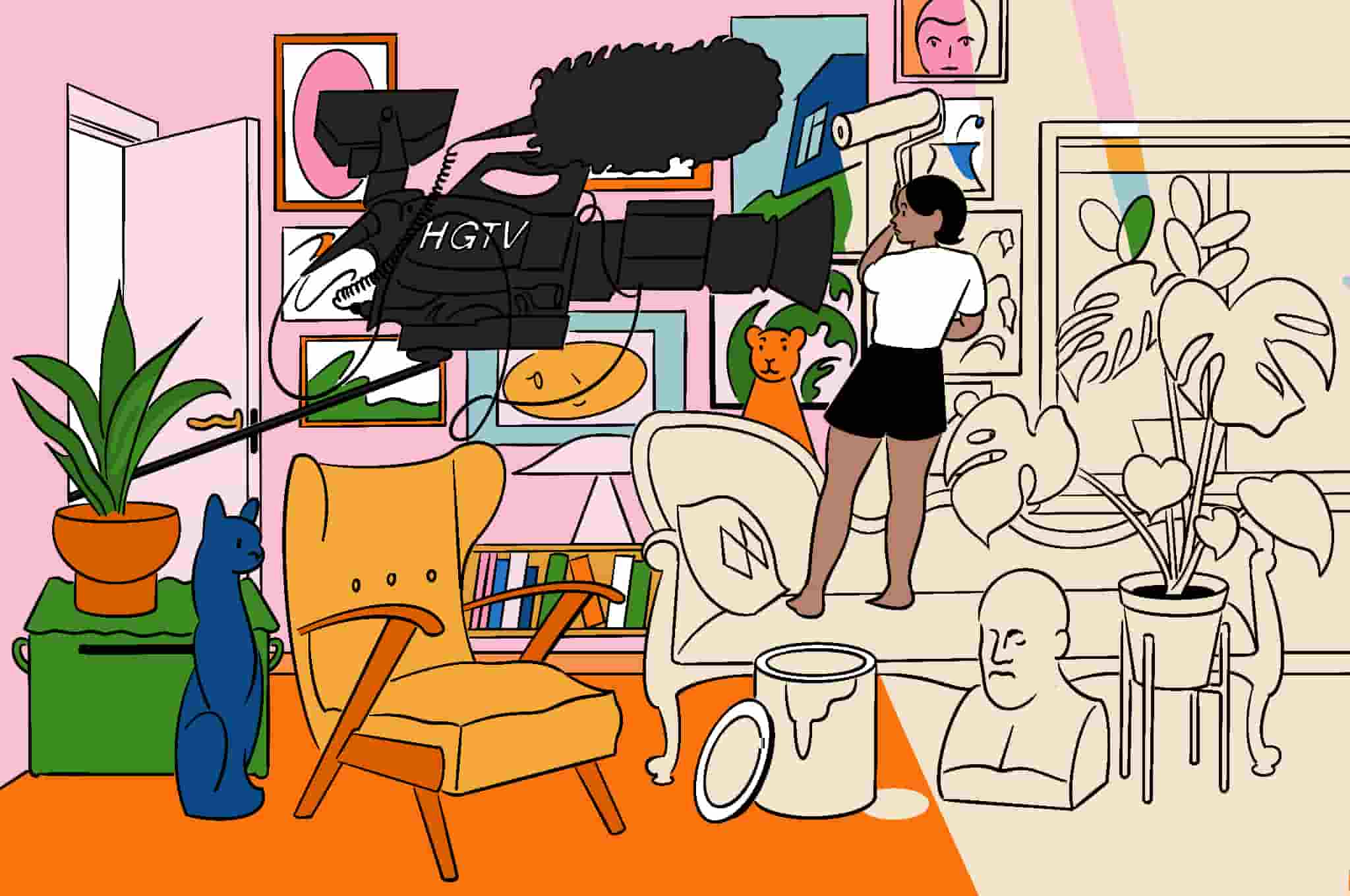HGTV, short for Home & Garden Television, is a popular television network that has become a cornerstone of the home improvement and real estate genre. Launched in 1994, the channel quickly gained widespread recognition, captivating audiences with its engaging content centered around interior design, home renovation, and lifestyle improvement. Over the years, HGTV has grown into a cultural phenomenon, attracting a diverse viewership of homeowners, aspiring DIY enthusiasts, and people seeking inspiration for their living spaces.
HGTV’s programming lineup features a variety of shows, each with its unique appeal and focus. One of the network’s most renowned programs is “House Hunters,” where prospective homebuyers explore three different properties and ultimately decide on their dream home.
The show’s formulaic structure and the opportunity to peek into diverse real estate markets around the world have garnered a dedicated fanbase.
Another crowd favorite is “Fixer Upper,” which stars the charismatic duo of Chip and Joanna Gaines. The couple helps homebuyers find affordable yet neglected properties, transforming them into stunning homes with their unparalleled design and renovation skills. The show’s wholesome family-friendly appeal and the couple’s infectious chemistry have made it a hit with viewers of all ages.
HGTV also offers programs that cater to specific interests and styles, such as “Property Brothers,” where twin brothers Jonathan and Drew Scott help individuals find, purchase, and remodel homes to meet their desires and budget.
“Love It or List It” is another popular show where homeowners decide whether to renovate their current homes or move to a new one.
In addition to renovation and real estate shows, HGTV airs content related to gardening, landscaping, and interior design. These programs showcase innovative ideas, expert tips, and DIY projects, inspiring viewers to take on their own home improvement ventures.
The success of HGTV goes beyond television programming. The network’s website provides a wealth of resources, including articles, videos, and tutorials, ensuring that fans can access content and inspiration at their convenience.
Social media platforms further amplify the network’s presence, allowing fans to engage with hosts, share their experiences, and participate in discussions about home improvement trends.
HGTV’s influence on popular culture is evident in the rise of the “HGTV effect,” where potential buyers and homeowners seek the same level of aesthetic and functional perfection depicted on the network in their own living spaces.
This phenomenon has driven an increased demand for stylish and modern home designs and has positively impacted the home improvement industry.
In recent years, HGTV has expanded its reach globally, catering to an international audience hungry for home improvement and real estate content. The network’s success has also led to the creation of spin-offs, specials, and collaborations with other media outlets, reinforcing its position as a leader in the genre.
Overall, HGTV continues to be a source of inspiration and entertainment for millions of viewers worldwide, fostering a shared passion for all things related to homes, gardens, and personal style.
As it evolves and adapts to changing trends and tastes, it remains a constant presence in the hearts and homes of those seeking to enhance their living spaces and create their own perfect abodes.
| Fact | Description |
|---|---|
| Name | HGTV (Home & Garden Television) |
| Launch Date | December 1, 1994 |
| Owner | Discovery, Inc. |
| Headquarters | Knoxville, Tennessee, USA |
| Genre | Home improvement, interior design, real estate, gardening, lifestyle |
| Audience | Homeowners, DIY enthusiasts, real estate enthusiasts, interior design enthusiasts |
| Programming | HGTV offers a diverse range of home improvement, renovation, real estate, and lifestyle-based shows. |
| Top Shows | – House Hunters<br>- Fixer Upper<br>- Property Brothers<br>- Love It or List It<br>- Flip or Flop |
| Website | https://www.hgtv.com/ |
| Social Media Presence | HGTV has a strong presence on various social media platforms, engaging with fans and promoting its content. |
| Global Reach | HGTV is available in several countries and has localized versions in some regions. |
| Cultural Impact | The “HGTV effect” has influenced real estate and home improvement trends, inspiring viewers to renovate |
| and design their living spaces according to the styles depicted on the network. | |
| Awards & Recognition | HGTV shows and hosts have received numerous awards and nominations for their contributions to the genre. |
| Spin-offs and Specials | HGTV has produced spin-off shows and special programming to cater to specific themes and events. |
| Streaming Services | Some HGTV shows are available on streaming platforms, making them accessible to cord-cutting audiences. |
Troubling News for HGTV Viewers
If you’ve ever indulged in a home makeover show on HGTV, you’re likely familiar with the essential “before” segment. It’s the moment when the camera meticulously scans the house while the host candidly highlights all the areas that require attention.
The decor? Chaotic. The paint? Uninspiring. The overarching message conveyed is that the home is an undeniable source of shame, desperately in need of a complete transformation before it could even hope to make a positive impression on discerning individuals who value aesthetics.
However, when individuals begin to contemplate how their own homes would measure up under such scrutiny, it can result in a pervasive homogeneity in terms of aesthetics.
Annetta Grant, an assistant professor specializing in markets, innovation, and design at Bucknell University, delved into this phenomenon through her research on the influence of home renovation media like HGTV and publications such as Better Homes and Gardens on homeowners.
Grant discovered that these sources exerted a significant impact, shaping and moulding the tastes and preferences of individuals seeking to renovate their homes.

Problem that might arise with Watching HGT Shows
In a collaborative research paper with Jay M. Handelman, an associate professor of marketing at Smith School of Business at Queen’s University in Kingston, Ontario, Annetta Grant coins the term “market-reflected gaze” to describe the notion that one’s decorating choices could be subjected to scrutiny or judgment.
The findings of Grant and Handelman were primarily derived from in-depth interviews conducted with 17 homeowners engaged in renovation projects.
According to Grant, homeowners often perceive their homes through a lens that magnifies every flaw, envisioning a scenario where visitors enter their space and subject it to criticism, scrutiny, and judgment.
This heightened awareness creates a sense of unease and apprehension, leaving individuals constantly anxious about making the wrong decisions when it comes to their home.
Despite multiple requests for comment from The Washington Post, HGTV did not provide a response.
In this context, the concept of “wrong” has been redefined to encompass decisions that may diminish the appeal of one’s home to potential buyers, even if there are no immediate plans to sell.
Homeowners find themselves caught between two conflicting notions of what their home should be, as explained by Grant.
On one hand, there is a prevailing belief that owning a home offers the dual advantages of building wealth and personalizing the living space according to individual tastes. Grant’s framework reveals that these two benefits are at odds with each other, presenting a challenge for homeowners.
Grant highlights that the pervasive gaze of scrutiny is leading to a noticeable “shift towards standardization.” Remarkably, this influence extends beyond areas of the house traditionally associated with guest reception.
Even bedrooms and primary bathrooms are subject to this gaze, prompting homeowners to conform to certain standardized expectations and styles.
Grant reveals that among the 17 individuals who participated in the research, the majority expressed a strong desire to become the “smart homeowner” who has made strategic investments in their home, resulting in a substantial increase in its market value.
As a result, they tend to prioritize cautious decision-making in their renovation and decor choices, often opting for more subdued options.
The prevailing trend leans heavily towards neutrals, with the overarching goal of creating a space that is universally appealing and devoid of any elements that might provoke offense. One interviewee named Gabrielle, who took part in the study, shared feedback she received regarding her renovated bathroom.
According to her, people were particularly complimentary about the bathroom due to its resemblance to a hotel room—clean, sleek, and exhibiting a coordinated aesthetic.
Homeowners’ inclination to safeguard their most significant asset is understandable. Moreover, they constantly find themselves inundated with data that attributes monetary value to seemingly minor decisions.
For instance, platforms like Zillow conduct analyses on paint colors and their impact on home prices.
In Zillow’s latest study, it was suggested that a white kitchen, previously considered a design staple, could potentially diminish a house’s value by approximately $612, whereas a charcoal-gray kitchen was claimed to increase the home’s value by an average of $2,512.
To obtain such precise figures, Zillow presented participants with various homes and inquired about the amount they would be willing to offer for each. Utilizing statistical modeling, the company’s behavioral scientists then determined how the relationship between list and offer prices varied based on room color.

In a press release concerning the paint analysis, Zillow quoted Mehnaz Khan, an interior designer and specialist in color psychology from Albany, N.Y. Khan remarked, “Buyers have been exposed to dark gray spaces through home improvement TV shows and their social media feeds, but they’re likely drawn to charcoal on a psychological level.”
Khan possesses expertise in analyzing the impact of colors and the built environment on individuals’ moods and overall well-being. However, when constructing her first house alongside her husband, she admits to falling into the same pattern of prioritizing external opinions over their personal preferences.
Despite being naturally drawn to unconventional and unique elements, Khan found herself swayed by her real estate agent’s constant emphasis on resale value.
This mantra became deeply ingrained, resulting in Khan feeling apprehensive about making any changes to the house. She lived with bare white walls, constantly fixated on the future homeowner, rather than allowing herself to personalize the space and create a sense of belonging.
Looking back, she expresses regret over not embracing the opportunity to infuse the home with her own personality.
Ruth DeSantis, a climate scientist from Calgary, Alberta, came across Grant’s research on Facebook and immediately connected with its findings. DeSantis describes the aesthetic promoted by HGTV as an unattainable and unrealistic pursuit of perfection, a style that she personally dislikes.
The research deeply resonated with DeSantis, as she had personal experiences with friends critiquing certain aspects of her kitchen, such as the white appliances. However, the findings of the research inspired her to embrace her preference for the white appliances, disregarding external opinions. She realized the importance of staying true to her own taste and avoiding unnecessary replacements, like switching to less appealing and harder-to-clean stainless-steel appliances. DeSantis highlights the concerning trend of people tearing out perfectly functional kitchens solely because they are deemed outdated by current color trends. She emphasizes the need for a shift in this mindset, considering the significant environmental impact of such practices.

Interior decorator Bona Gjoni, who operates in Washington, often advises clients against chasing fleeting trends. When clients inquire about the trendiness of certain choices, Gjoni discourages them from following transient fads. She cautions that trends come and go, and investing heavily in popular finishes like gold may result in the need for reinvestment in just a few years.
Grant’s research aligns with these perspectives. She discovered that even if homeowners renovate their homes according to the latest standards, the ever-changing nature of these standards leads them to contemplate their next renovation as soon as the current one is completed. The continuous cycle of chasing trends perpetuates a mindset of constant renovation and leaves homeowners in a perpetual state of planning for the next update.











